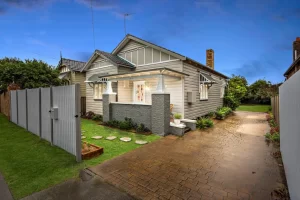Affordable regional areas within commuting distance to central business districts are poised to rack up strong house price growth in the near term despite the slowing city markets, as buyers seek out cheaper housing options and take advantage of the hybrid working arrangements, experts say.
Suburbs located up to 200 kilometres from the Sydney CBD, which offer desirable lifestyles, could also achieve better rental returns amid tight rental supply and strong demand from tenants.
Lake Macquarie, Newcastle, the Blue Mountains and the Hawkesbury region in NSW are among those predicted to notch strong gains as their neighbouring regions become too expensive for homebuyers.
In Queensland, houses in Robina on the Gold Coast and Buderim on the Sunshine Coast are also expected to perform strongly, as well as those in Onkaparinga and the Fleurieu Peninsula in SA.
“These areas are all benefiting from the next significant trend, which is the pursuit of affordability and lifestyle,” said Kent Lardner, research director of Suburbtrends.
“These markets offer reasonable yields for a well-priced home and the better than average future growth makes them even more appealing.”
The affordable offerings in Newcastle have enticed Sydney couple Jahan Kalantar and Hannah Bourke to buy two properties in the area in the past few months – one to live in and the other as an investment property.
Mr Kalantar, a lawyer and Ms Bourke, a pharmaceutical brand manager, also maintain a home in Sydney’s eastern suburbs.
“I was finding that Sydney was becoming overly expensive and that I could get much better value for money out of somewhere like Newcastle, so we decided to buy there,” Mr Kalantar said.
“My partner, Hannah, is from Newcastle, and I’ve fallen in love with the place. It’s a beautiful regional hub with great beaches.”
Mr Kalantar said the ability to work from home enabled them to split their time between their Sydney and Newcastle homes.
“I think the lifestyle that places like Newcastle offer to young professionals like us is more appealing than Sydney and you can get quite good value for money, which is harder to come by in Sydney,” he said.
“By working maybe half a week in Sydney and half the week in Newcastle, it gives us the opportunity to enjoy the wonderful beaches in Newcastle and still be able to do my role in Sydney. It’s the best of both worlds.”
Buyer’s agent Jack Henderson of Henderson Advocacy, who helped Mr Kalantar secure their Newcastle properties, said despite the strong demand from Sydney buyers, house prices in the Lake Macquarie and Newcastle areas remain affordable.
“I think they still offer good value and there’s still a long way for prices to go and compared to Sydney; they’re still very affordable for what you get,” he said.
Zachary Sykes, a Newcastle-based buyer’s agent, said a growing number of western Sydney buyers who were upgrading from their apartments have been active in the area.
“These buyers can get a three-bedroom house for around $700,000 in relatively nice areas, and it’s only about an hour and a half away from Sydney,” he said. “They can work from home most days and only travel to the city once or twice a week and enjoy a nice spacious house.”
Domain chief of research and economics Nicola Powell said the hybrid working arrangements will continue to fuel demand for regional properties.
“While we will see the return to the office, I think many of us will adopt the hybrid life now where we do the focused work at home and collaboration in the office,” she said.
“What that means for housing is it does push the radius of where somebody might be willing to rent or move to. If they’ve only got to commute two days a week rather than five days, then it’s a bit easier to swallow.
“So it opens up the commutable belt as it were, around our main cities, or our main working hubs.”
Demographer Mark McCrindle said the regions will continue to attract buyers, especially the younger generation.
“These younger buyers are still chasing their dream home, and they’re quite happy to consider a regional or outer fringe area to get it,” he said.
“Because it’s not about the status of a suburb any more. And again, if we take the flexibility of work into account, the city has lost a little bit of status. Affordability is driving buyers and they’re quite happy to make compromises on location.”
This article is from Australian Financial Review, please click the following link for the original article: https://www.afr.com/property/residential/commuting-distance-suddenly-has-a-new-meaning-for-regional-property-20211111-p5987s




